Bovine serum albumin aggravates macrophage M1 activation and kidney injury in heterozygous Klotho-deficient mice via the gut microbiota-immune axis
- PMID: 33767585
- PMCID: PMC7975693
- DOI: 10.7150/ijbs.56424
Bovine serum albumin aggravates macrophage M1 activation and kidney injury in heterozygous Klotho-deficient mice via the gut microbiota-immune axis
Abstract
Klotho expression abnormalities induces kidney injury and chronic kidney disease, however, the underlying mechanism remains unclear. Here, Klotho+/- mice and wild-type mice were treated with low-dose bovine serum albumin (BSA). Pathological examination demonstrated that the area of glomerular collagen deposition and fibrosis in BSA-Kl-/+ mice was significantly larger than that in BSA-WT mice. The serum levels of superoxide dismutase, malondialdehyde, creatinine, and urea in BSA-Kl-/+ mice were significantly increased. Sequencing of gut microbiota 16S rRNA v3-v4 region indicated that BSA-Kl-/+ mice showed a significantly higher relative abundance of the genera Dubosiella, Akkermansia, Alloprevotella, and Lachnospiraceae and a significantly lower relative abundance of the genera Allobaculum and Muribaculaceae than BSA-WT mice. KEGG analysis revealed that the metabolic pathways of signal transduction, xenobiotic biodegradation and metabolism, and lipid metabolism increased significantly in BSA-Kl-/+ mice. Flow cytometry showed that the proportion of CD68+/CD11b+ cells in the peripheral blood was significantly higher in BSA-KL-/+ mice than that in BSA-WT mice. qPCR and western blot suggested that Klotho and Nrf2 expression in MΦ1 cells of BSA-KL-/+ mice was significantly decreased. Thus, the findings suggest during the immune activation and chronic inflammation induced by the gut microbiota imbalance in Klotho-deficient mice treated to BSA, disrupted expression of proteins in the Nrf2/NF-κB signaling pathway in monocyte-derived macrophage M1 cells leads to the aggravation of inflammation and kidney injury.
Keywords: Klotho; Nrf2/NF-κB pathway; gut microbiota; kidney injury; macrophage M1.
© The author(s).
Conflict of interest statement
Competing Interests: The authors have declared that no competing interest exists.
Figures
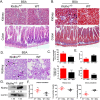



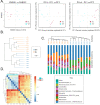
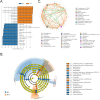
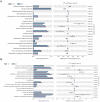
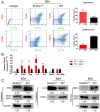

Similar articles
-
Klotho restrain RIG-1/NF-κB signaling activation and monocyte inflammatory factor release under uremic condition.Life Sci. 2019 Aug 15;231:116570. doi: 10.1016/j.lfs.2019.116570. Epub 2019 Jun 14. Life Sci. 2019. PMID: 31207307
-
NOD2 Deficiency Promotes Intestinal CD4+ T Lymphocyte Imbalance, Metainflammation, and Aggravates Type 2 Diabetes in Murine Model.Front Immunol. 2020 Jul 7;11:1265. doi: 10.3389/fimmu.2020.01265. eCollection 2020. Front Immunol. 2020. PMID: 32774333 Free PMC article.
-
Chronic nicotine exposure reduces klotho expression and triggers different renal and hemodynamic responses in klotho-haploinsufficient mice.Am J Physiol Renal Physiol. 2018 May 1;314(5):F992-F998. doi: 10.1152/ajprenal.00442.2016. Epub 2018 Jan 24. Am J Physiol Renal Physiol. 2018. PMID: 29363324
-
The gut-liver-kidney axis: Novel regulator of fatty liver associated chronic kidney disease.Pharmacol Res. 2020 Feb;152:104617. doi: 10.1016/j.phrs.2019.104617. Epub 2019 Dec 24. Pharmacol Res. 2020. PMID: 31881272 Review.
-
[alpha Klotho and inorganic phosphate metabolism].Clin Calcium. 2007 May;17(5):698-703. Clin Calcium. 2007. PMID: 17470998 Review. Japanese.
Cited by
-
Crosstalk between gut microbiota and renal ischemia/reperfusion injury.Front Cell Infect Microbiol. 2022 Sep 5;12:1015825. doi: 10.3389/fcimb.2022.1015825. eCollection 2022. Front Cell Infect Microbiol. 2022. PMID: 36132990 Free PMC article. Review.
-
A Historical Perspective on Uremia and Uremic Toxins.Toxins (Basel). 2024 May 15;16(5):227. doi: 10.3390/toxins16050227. Toxins (Basel). 2024. PMID: 38787079 Free PMC article. Review.
-
Causal effect of gut microbiota and diabetic nephropathy: a Mendelian randomization study.Diabetol Metab Syndr. 2024 Apr 24;16(1):89. doi: 10.1186/s13098-024-01327-7. Diabetol Metab Syndr. 2024. PMID: 38658966 Free PMC article.
-
Inflammation-Induced Klotho Deficiency: A Possible Key Driver of Chronic Kidney Disease Progression.Int J Gen Med. 2025 May 11;18:2507-2520. doi: 10.2147/IJGM.S513497. eCollection 2025. Int J Gen Med. 2025. PMID: 40376197 Free PMC article. Review.
-
Establishing a prognostic model of ferroptosis- and immune-related signatures in kidney cancer: A study based on TCGA and ICGC databases.Front Oncol. 2022 Aug 26;12:931383. doi: 10.3389/fonc.2022.931383. eCollection 2022. Front Oncol. 2022. PMID: 36091132 Free PMC article.
References
-
- Jha V, Garcia-Garcia G, Iseki K, Li Z, Naicker S, Plattner B. et al. Chronic kidney disease: global dimension and perspectives. Lancet. 2013;382:260–72. - PubMed
-
- Pluznick JL. The gut microbiota in kidney disease. Science. 2020;369:1426–7. - PubMed
-
- Antza C, Stabouli S, Kotsis V. Gut microbiota in kidney disease and hypertension. Pharmacol Res. 2018;130:198–203. - PubMed
-
- Onal EM, Afsar B, Covic A, Vaziri ND, Kanbay M. Gut microbiota and inflammation in chronic kidney disease and their roles in the development of cardiovascular disease. Hypertens Res. 2019;42:123–40. - PubMed
Publication types
MeSH terms
Substances
LinkOut - more resources
Full Text Sources
Other Literature Sources
Medical
Molecular Biology Databases
Research Materials

